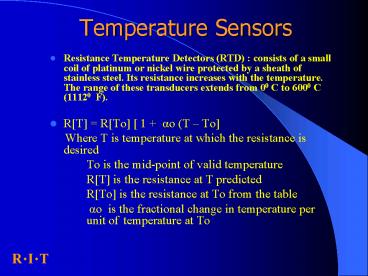Temperature Sensors - PowerPoint PPT Presentation
1 / 9
Title:
Temperature Sensors
Description:
Title: Your Presentation (Name) Author: kwheec Last modified by: kwheec Created Date: 9/9/2005 7:56:06 PM Document presentation format: On-screen Show – PowerPoint PPT presentation
Number of Views:142
Avg rating:3.0/5.0
Title: Temperature Sensors
1
Temperature Sensors
- Resistance Temperature Detectors (RTD) consists
of a small coil of platinum or nickel wire
protected by a sheath of stainless steel. Its
resistance increases with the temperature. The
range of these transducers extends from 00 C to
6000 C (11120 F). - RT RTo 1 ao (T To
- Where T is temperature at which the
resistance is desired - To is the mid-point of valid temperature
- RT is the resistance at T predicted
- RTo is the resistance at To from the table
- ao is the fractional change in temperature
per unit of temperature at To
2
Cont.
- The value a all metals will be on the order of
0.4 of the RTD resistance for every change of 10
C, in other words, the value is 0.004 / 0 C . - RTD has drawbacks
- Power dissipation factor
- Self heating effect
- Delay time constant
- non-lineariarity
3
Thermistors
- Thermistor is a semiconductor based transducers.
It has very good sensitivity. It is 10. It is
good for small temperature variations. - Drawbacks
- Self heating effect
- Time constant
- Power Dissipation
- Time Delay
4
Thermocouple (TC)
- The thermocouple (TC) is a temperature sensor
that produces a voltage directly as a function of
temperature. The range is from - -150 0 C to 2000 0 C
- Interpolation
- T(V) T1 T2 - T1V V1/V - V1
5
Cont.
- There are types E, J, K, C, R, S
- R and S are high temperature sensors used to
measure temperature in the semiconductor furnace
as the one in the Microelectronic Engineering
clean room.
6
Thermocouple Comparison Data
- Type Elements mv/0 C Range0C Error(FS)
Appliction - E Chromel/Constantan 0.044 0 to 800 0.5
High output - J Iron/constantan 0.033 -250 to 700 0.75
Reducing atm - K Chromel/Alumel 0.020 -250 to 1200 0.75
Oxidizing - R S Pt-Rh/Platinum 0.010 0 to 1400
0.25 Corrosive - T Copper/Constantan 0.040 -250 to 350
1.00 Moist - C Tungsten/rhenium 0.012 0 to 2000
0.5 High temp.
7
Displacement Sensors
- Potentiometric Its resistance varies as its
wiper position changes. - Inexpensive
- Physical contact wears out after long hours of
use, generating noise as a result.
8
Linear Variable Differential Transformer (LVDT)
- LVDT is based on the electrical transformer
- The difference of output voltages of two
secondary winding changes according to the
position of the core. AC signal is used,
typically 1000 Hz signal is used as the source
signal. Phase sensitive detector can be used to
convert AC to DC output.
9
Strain Gage
- Its resistance changes as the platinum wire
changes its length and cross-sectional area. - GF (dR/R)/(dL/L)
- Where
- GF is gage factor
- dR/R is resistance ratio
- dL/L fractional change in length, which is
called the strain.































